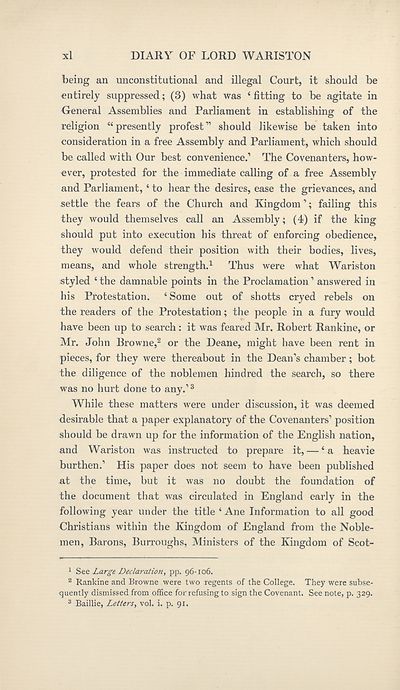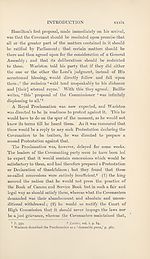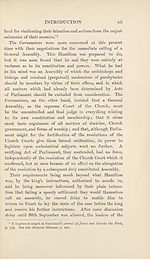Series 1 > Diary of Sir Archibald Johnston of Wariston 1632-1639
(45) Page xl
Download files
Complete book:
Individual page:
Thumbnail gallery: Grid view | List view

xl
DIARY OF LORD WARISTON
being an unconstitutional and illegal Court, it should be
entirely suppressed; (3) what was ‘ fitting to be agitate in
General Assemblies and Parliament in establishing of the
religion “presently profest” should likewise be taken into
consideration in a free Assembly and Parliament, which should
be called with Our best convenience.’ The Covenanters, how¬
ever, protested for the immediate calling of a free Assembly
and Parliament, ‘ to hear the desires, ease the grievances, and
settle the fears of the Church and Kingdom ’; failing this
they would themselves call an Assembly; (4) if the king
should put into execution his threat of enforcing obedience,
they would defend their position with their bodies, lives,
means, and whole strength.1 Thus were what Wariston
styled ‘ the damnable points in the Proclamation ’ answered in
his Protestation. ‘ Some out of shotts cryed rebels on
the readers of the Protestation; the people in a fury would
have been up to search: it was feared Mr. Robert Rankine, or
Mr. John Browne,2 or the Deane, might have been rent in
pieces, for they were thereabout in the Dean’s chamber; bot
the diligence of the noblemen hindred the search, so there
was no hurt done to any.’3
While these matters were under discussion, it was deemed
desirable that a paper explanatory of the Covenanters’ position
should be drawn up for the information of the English nation,
and Wariston was instructed to prepare it, — ‘a heavie
burthen.’ His paper does not seem to have been published
at the time, but it was no doubt the foundation of
the document that was circulated in England early in the
following year under the title ‘ Ane Information to all good
Christians within the Kingdom of England from the Noble¬
men, Barons, Burroughs, Ministers of the Kingdom of Scot-
1 Sts Large Declaration, pp. 96-106.
2 Rankine and Browne were two regents of the College. They were subse¬
quently dismissed from office for refusing to sign the Covenant. See note, p. 329.
3 Baillie, Letters, vol. i. p. 91.
DIARY OF LORD WARISTON
being an unconstitutional and illegal Court, it should be
entirely suppressed; (3) what was ‘ fitting to be agitate in
General Assemblies and Parliament in establishing of the
religion “presently profest” should likewise be taken into
consideration in a free Assembly and Parliament, which should
be called with Our best convenience.’ The Covenanters, how¬
ever, protested for the immediate calling of a free Assembly
and Parliament, ‘ to hear the desires, ease the grievances, and
settle the fears of the Church and Kingdom ’; failing this
they would themselves call an Assembly; (4) if the king
should put into execution his threat of enforcing obedience,
they would defend their position with their bodies, lives,
means, and whole strength.1 Thus were what Wariston
styled ‘ the damnable points in the Proclamation ’ answered in
his Protestation. ‘ Some out of shotts cryed rebels on
the readers of the Protestation; the people in a fury would
have been up to search: it was feared Mr. Robert Rankine, or
Mr. John Browne,2 or the Deane, might have been rent in
pieces, for they were thereabout in the Dean’s chamber; bot
the diligence of the noblemen hindred the search, so there
was no hurt done to any.’3
While these matters were under discussion, it was deemed
desirable that a paper explanatory of the Covenanters’ position
should be drawn up for the information of the English nation,
and Wariston was instructed to prepare it, — ‘a heavie
burthen.’ His paper does not seem to have been published
at the time, but it was no doubt the foundation of
the document that was circulated in England early in the
following year under the title ‘ Ane Information to all good
Christians within the Kingdom of England from the Noble¬
men, Barons, Burroughs, Ministers of the Kingdom of Scot-
1 Sts Large Declaration, pp. 96-106.
2 Rankine and Browne were two regents of the College. They were subse¬
quently dismissed from office for refusing to sign the Covenant. See note, p. 329.
3 Baillie, Letters, vol. i. p. 91.
Set display mode to:
![]() Universal Viewer |
Universal Viewer | ![]() Mirador |
Large image | Transcription
Mirador |
Large image | Transcription
Images and transcriptions on this page, including medium image downloads, may be used under the Creative Commons Attribution 4.0 International Licence unless otherwise stated. ![]()
| Scottish History Society volumes > Series 1 > Diary of Sir Archibald Johnston of Wariston 1632-1639 > (45) Page xl |
|---|
| Permanent URL | https://digital.nls.uk/127531369 |
|---|
| Attribution and copyright: |
|
|---|
| Description | Over 180 volumes, published by the Scottish History Society, containing original sources on Scotland's history and people. With a wide range of subjects, the books collectively cover all periods from the 12th to 20th centuries, and reflect changing trends in Scottish history. Sources are accompanied by scholarly interpretation, references and bibliographies. Volumes are usually published annually, and more digitised volumes will be added as they become available. |
|---|


